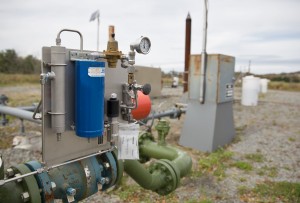After more than two year DEP delay, industry will begin state-mandated well inspections
-
Katie Colaneri

Linsay Lazarski / WHYY
A Williams system measures how much gas the well is producing in Springville Township, Pa. and transports the gas through gathering pipelines to market.
The Pennsylvania Department of Environmental Protection says it is ready to implement a well inspection program after delaying the requirement for more than two and a half years, according to the Pittsburgh Post-Gazette.
Since February 2011, energy companies have been required to perform “mechanical integrity inspections” of each operating well four times a year and file the results with the DEP on an annual basis. But the Post-Gazette reports the DEP postponed the inspections in order to come up with an electronic system for receiving and compiling all of the data.
More from the Pittsburgh Post-Gazette:
Companies have to monitor and report the pressure in their wells, as well as check for escaping or flowing gas, brine or liquid hydrocarbons and signs of severe corrosion. The state is not requiring companies to retrofit their wells with gauges or meters or dig out buried parts in order to report this information, although it suggests companies should renovate wells to make monitoring easier if they have the chance. According to one DEP tip sheet, “Only those components of the inspection that can be completed must be completed.”
The Department of Environmental Protection and industry organizations have held training sessions this fall to prepare companies to conduct the first round of inspections before the year is over.
“Obviously there are a number of folks that feel that the DEP does not do a good enough job inspecting existing wells,” Mr. Perry said.
While the department does not think it is necessary to assign inspectors to look at all wells each year, regulators “do nonetheless believe it is important that somebody put a serious eyeball on it and document the results,” he said, “which is why we developed that rule.”
The Post-Gazette reports the well program was also held up by another, more controversial project to create a guidance for companies on what to do if their inspections turned up any serious problems.
DEP designed a series of tests to distinguish between wells that pose an environmental or safety risk and those that are flawed but fundamentally safe. Depending on the well’s performance on each test, the plan might prescribe more tests, monitoring or immediate action.
For a time, the standard quarterly inspection program merged with this more comprehensive testing procedure. The result — a mazy flow chart and 23-page guidance document — was panned by the industry as too onerous for routine inspections and an overreach of the department’s authority.
“Rather than responding to a problem, this proposal assumes that wells are causing a problem and then makes the operator prove, over and over again, that no problem exists,” the Pennsylvania division of the American Petroleum Institute wrote in its comments on a draft of the flow chart last summer.
The Department of Environmental Protection eventually revised, redrew and split the chart into a separate regulatory tool that can be used to deal with wells with recognized flaws, especially new and high-pressure wells that tap shale formations. Some operators are following it to test and correct wells, Mr. Perry said.
Despite the industry’s criticism of the evaluation process, every well with defective cement will be scrutinized, either through the proposed procedure or another that is scientifically sound, he said.
















